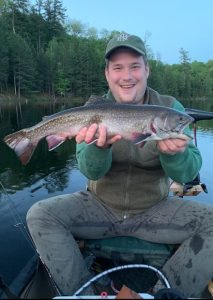The brook trout, or Salvelinus fontinalis, is the state fish of New York – and is one of the most sought-after fish in the region. Brook trout, or brookies, are colorful fish that populate streams and ponds throughout the northeastern U.S. They’re fans of cold, clean water (not over 68 degrees, please) and tend to live in streams and ponds.
Use this Adirondack brook trout fishing guide to enjoy angling for this popular fish.

Where to find brook trout
Brookies were once plentiful in the streams that feed Adirondacks lakes; however, their need for cold, clean water, their sensitivity to the increasing acidity of many waters, and the accidental introduction of competing, non-native species have combined to severely reduce the brook trout population.
There’s still good brookie fishing in the Adirondacks, though. The New York Department of Environmental Conservation (DEC) has a map of streams that are good brook trout areas.
If you go for stream fishing, though, be prepared for fish that are 5-9 inches. These smaller, younger fish tend to populate the shallower areas of streams where they’re easier for predators to see while older brook trout are in the deeper pools in these streams. However, the larger brook trout can be found in ponds.
Pond waters fed by cold, clean streams are ideal habitats for brook trout. The water needs to be about 68 degrees or colder and not acidic. Brookies like dark, covered areas where they’re protected. They frequently are found in waters sheltered by bogs and overhanging greenery, or they may hide under submerged logs or rocks. Their diet consists of insects so they may also hang out in drop-offs created by stream inlets. Here trout can hang out and have insects carried downstream to them.
When to fish for brook trout
In New York, the official brook trout season is from April 1st to October 15th. However, you can fish year-round on most waters if you’re practicing catch-and-release fishing.
Since brookies are shy, they tend to be active during the less sunny parts of the day, that is, early morning and around sunset. They like cloudy weather and even rainy days.
Also, brookies are likely to seek deeper, cooler waters during hot summer days. This has an impact on what baits and fishing methods will be more successful.
How to fish for brook trout
Many stream fishing anglers prefer fly fishing with a short rod since the streams can be narrow and overhung with trees and bushes. A long rod can be used with an underhand cast to avoid getting tangled. A spinner rod could be used as well. Depending on the pond, fly fishing or spin casting can work well.
The diet of a brook trout is primarily insects so bait choices should reflect that. If you’re using artificial bait, match your flies to the insects you see in the environment. Live bait, like small worms and crickets, can work as well.
A recommended method is to cast upstream from where the fish are and let the current carry your bait hook downstream to the fish. This mimics the way food usually comes to brook trout.
Brook trout fishing ponds in the Adirondacks
A good pond for brookies is one that is stream-fed and cold with good cover for the fish. Ph can’t be too acidic, and there should be no invasive species with which the brookies must compete. (Some ponds have a no-bait-fish rule to prevent the accidental introduction of non-native species.)
The New York DEC lists a number of brook trout ponds in the Adirondack/Lake Champlain area Essex County, in northeastern New York has a wealth of brook trout ponds in the Hammond Ponds Wild Forest, Pharaoh Lakes Wilderness, and other areas.
Enjoy brook trout fishing at Twin Ponds Preserve
 Twin Ponds Preserve offers 500 acres of perfect habitats for brook trout. This stream-fed pond offers the cold, clean water brookies need. Plus, Twin Ponds has a unique floating bog that provides unparalleled cover for the fish. In these pristine waters, you can catch trophy-sized brook trout of 14 inches and up.
Twin Ponds Preserve offers 500 acres of perfect habitats for brook trout. This stream-fed pond offers the cold, clean water brookies need. Plus, Twin Ponds has a unique floating bog that provides unparalleled cover for the fish. In these pristine waters, you can catch trophy-sized brook trout of 14 inches and up.
In order to preserve the brook trout species, all fishing on Twin Ponds is catch and release.
Premier Fishing Land for Sale at Twin Ponds Preserve
Owning your own piece of land on a secluded pond where trophy-sized brook trout are plentiful doesn’t just have to be a dream. At Twin Ponds Preserve it’s a reality. Browse our available waterfront properties for sale or contact our team today to get started!

